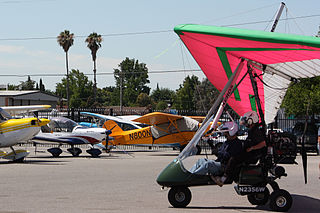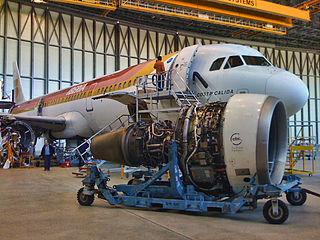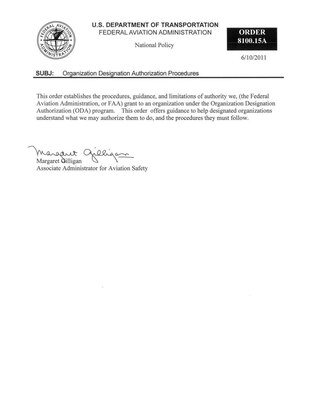
The Federal Aviation Administration (FAA) is the largest transportation agency of the U.S. government and regulates all aspects of civil aviation in the country as well as over surrounding international waters. Its powers include air traffic control, certification of personnel and aircraft, setting standards for airports, and protection of U.S. assets during the launch or re-entry of commercial space vehicles. Powers over neighboring international waters were delegated to the FAA by authority of the International Civil Aviation Organization.
The Federal Aviation Regulations (FARs) are rules prescribed by the Federal Aviation Administration (FAA) governing all aviation activities in the United States. The FARs comprise Title 14 of the Code of Federal Regulations (CFR). A wide variety of activities are regulated, such as aircraft design and maintenance, typical airline flights, pilot training activities, hot-air ballooning, lighter-than-air aircraft, man-made structure heights, obstruction lighting and marking, model rocket launches, commercial space operations, model aircraft operations, Unmanned Aircraft Systems (UAS) and kite flying. The rules are designed to promote safe aviation, protecting pilots, flight attendants, passengers and the general public from unnecessary risk.
A standard certificate of airworthiness is a permit for commercial passenger or cargo operation, issued for an aircraft by the civil aviation authority in the state/nation in which the aircraft is registered. For other aircraft such as crop-sprayers, a Special Airworthiness Certificate must be issued.

A type certificate signifies the airworthiness of a particular category of aircraft, according to its manufacturing design. Certification confirms that the aircraft of a new type intended for serial production is in compliance with applicable airworthiness requirements established by the national air law.

A light-sport aircraft (LSA), or light sport aircraft, is a fairly new category of small, lightweight aircraft that are simple to fly. LSAs tend to be heavier and more sophisticated than ultralight aircraft, but LSA restrictions on weight and performance separates the category from established GA aircraft. There is no standard worldwide description of an LSA.
DO-178B, Software Considerations in Airborne Systems and Equipment Certification is a guideline dealing with the safety of safety-critical software used in certain airborne systems. It was jointly developed by the safety-critical working group RTCA SC-167 of the Radio Technical Commission for Aeronautics (RTCA) and WG-12 of the European Organisation for Civil Aviation Equipment (EUROCAE). RTCA published the document as RTCA/DO-178B, while EUROCAE published the document as ED-12B. Although technically a guideline, it was a de facto standard for developing avionics software systems until it was replaced in 2012 by DO-178C.
RTCA DO-254 / EUROCAE ED-80, Design Assurance Guidance for Airborne Electronic Hardware is a document providing guidance for the development of airborne electronic hardware, published by RTCA, Incorporated and EUROCAE. The DO-254/ED-80 standard was formally recognized by the FAA in 2005 via AC 20-152 as a means of compliance for the design assurance of electronic hardware in airborne systems. The guidance in this document is applicable, but not limited, to such electronic hardware items as
A Technical Standard Order (TSO) is a minimum performance standard issued by the United States Federal Aviation Administration for specified materials, parts, processes, and appliances used on civil aircraft. Articles with TSO design approval are eligible for use on the United States type certified products by following a much lighter process than similar non-TSO approved part, provided the TSO standard meets the aircraft requirements. The TSO authorization or a letter of TSO Design Approval does not necessarily convey approval for installation. See 14 CFR Part 21 Subpart O.
An aircraft part is an article or component approved for installation on a type-certificated aircraft. Approval for these parts is derived from the jurisdictions of the countries that an aircraft is based. In the United States, the Federal Aviation Administration oversees the approval for these parts under Federal Aviation Regulation Part 21.
Parts Manufacturer Approval (PMA) is an approval granted by the United States Federal Aviation Administration (FAA) to a manufacturer of aircraft parts.

In aviation, airworthiness is the measure of an aircraft's suitability for safe flight. Initial airworthiness is demonstrated by a certificate of airworthiness issued by the civil aviation authority in the state in which the aircraft is registered, and continuing airworthiness is achieved by performing the required maintenance actions.

Aircraft maintenance is the performance of tasks required to ensure the continuing airworthiness of an aircraft or aircraft part, including overhaul, inspection, replacement, defect rectification, and the embodiment of modifications, compliance with airworthiness directives and repair.

In aviation, V-speeds are standard terms used to define airspeeds important or useful to the operation of all aircraft. These speeds are derived from data obtained by aircraft designers and manufacturers during flight testing for aircraft type-certification. Using them is considered a best practice to maximize aviation safety, aircraft performance, or both.
A Designated Airworthiness Representative (DAR) is a private person designated by the United States Federal Aviation Administration to act on its behalf in the certification of type certificated and amateur-built aircraft for the issuance of airworthiness certificates, special flight permits, import aircraft, export certificates for products and articles, conformity inspections, and field approvals for repair and alterations. Most DARs have limited and/or certain "functions" authorized by the FAA based on their experience and technical background. A DAR may charge a fee for their services. Qualifications and policies for appointment of Designated Airworthiness Representatives are established in FAA Order 8100.8.
The Modification and Replacement Parts Association is the Washington, D.C.-based trade association that represents manufacturers of government-approved after market aircraft parts. These aircraft parts are often known as PMA parts, from the acronym for Parts Manufacturer Approval. The manufacture of PMA parts is regulated in the United States by the Federal Aviation Administration.

Blade off testing or blade out testing is a specific form of air safety testing required by the Federal Aviation Administration and other safety agencies to certify safety performance of jet engines. The tests require engine manufacturers to carry out at least two tests of the engine, to make sure that the engine can survive a compressor or fan blade breaking off within the engine and a turbine blade breaking off within the engine, without fragments being thrown through the outside enclosure of the engine, creating a contained engine failure.
The Aviation Safety Knowledge Management Environment (ASKME) is a software suite for certifying new aircraft and modified aircraft. It was created for the Federal Aviation Administration (FAA) Aircraft Certification Service (AIR).

FAA Order 8100.8 , Designee Management Handbook, establishes "policy and procedures for the selection, appointment, orientation, training, oversight, renewal tracking, and termination of certain representatives of the Administrator" of the Federal Aviation Administration. In particular, it is a resource for individuals interested in becoming a Designated Engineering Representative (DER).

The Organization Designation Authorization (ODA) program was established by FAA Order 8100.15 . The ODA, in conjunction with the FAA, grants airworthiness designee authority to organizations or companies. The regulations addressing the ODA program are found in Title 14 of the Code of Federal Regulations part 183, subpart D, sections 183.41 through 813.67.

FAA Order 8110.105A, Simple and Complex Electronic Hardware Approval Guidance, supplements RTCA DO-254 by explaining how FAA aircraft certification staff can use that document "when working on certification projects" and is recommended as a reference for developers applying for certification under DO-254. A particular focus is on clarification of the application of DO-254 guidance to "simple" custom micro-coded components as opposed to the more rigorous assurance expected of complex custom micro-coded components. Micro-coded devices are typically presumed to be complex components that cannot be verified through testing alone; however, some applicants have proposed their specific micro-coded device applications as simple components.








